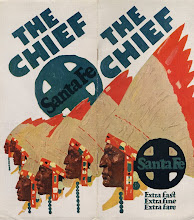
Last evening, Dr. Aurora G. Morcillo brought the graduate students in her Historical Methods class to our rare books and special collections library for a presentation by Mellon grant coordinator Jon Mogul and yours truly. The aim was to expose the students to some of the nonliterary primary source materials in our library and to help them learn how to “read” and make sense of the visual imagery and physicality of the artifacts. It is hoped that after their visit the students might began thinking about utilizing such materials not merely as illustrations, but as evidence as compelling and potentially revealing as anything offered in some of the more traditional literary sources. The library table in our main reading room was laid out in advance of their arrival with an array of diverse materials covering five areas of strength from our collection: World’s Fair catalogs and ephemera; a wide variety of items documenting various colonial projects of the late nineteenth and twentieth century; all manner of propaganda produced in the Soviet Union; Spanish Civil War leaflets and vintage postcards; and a variety of rare books, calendars, and portfolios illustrated by American Socialist and Communist artists in the 1930s.


Starting with the VTS (Visual Thinking Strategies) methodology, the students were asked to look at and describe exactly what they saw in the artifacts until the group collectively exhausted the imagery of the items. In order to interpret and make sense of the objects, the students were next asked to think about these same designed objects in the historical, social, and cultural context of the times in which they were made. They were encouraged to think about who produced the work and for what intent? Who was the intended audience? Was there a subtext or subliminal message buried in the text or image that the historical audience might have immediately or subconsciously recognized? How was the message meant to be distributed? Was there some relationship between the design of the object (photograph, photomontage, linocut, illustration, and caricature), its form (exhibition catalog, postcard, leaflet, and handbill) and the ideology its creators espoused?

I have included one item from each of the five categories mentioned above so that my readers might also have a chance to try their hand at parsing and interpreting the items for themselves. Feel free to comment with your own impressions and interpretations of these historical artifacts.


No comments:
Post a Comment